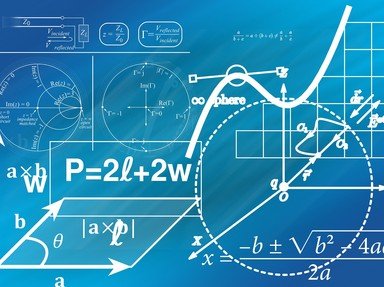Quiz Answer Key and Fun Facts
1. Connie likes to generate conic sections. How many different (non-degenerate) ones can she generate?
2. How does Connie generate conic sections? She intersects a plane with a ___________. (She is able to generate all of the conic sections this way)
3. Connie likes her parabolas. Every now and then, however, she comes across a degenerate in her collection. Which of the following could NOT be a degenerate parabola?
4. Connie likes to draw different shapes. One shape she gets by drawing all points that are the same distance from a fixed point as they are from a fixed line. What conic section would this shape correspond to?
5. Connie often finds it hard to direct and focus her attention. If she is drawing a conic section using the "eccentricity" definition (this is the ratio of distances between a given point on the conic and a fixed point divided by the distance to a fixed line), what is the term for the fixed point?
6. Sometimes Connie likes to draw her conics a different way. One conic section can be described as the set of all points such that the sum of the distances from a given point to two fixed points is a constant. What conic section is this?
7. Connie likes to star gaze; she loves Orion, the Big Dipper, and Brad Pitt. The planets orbit the sun in the shape of a conic section, which one is it?
8. The word "ellipse" comes from the Greek word "ellipsis" which means "deficiency". Connie's cousin, Miss Polly Nomial, asked her why they would name the ellipse this way. What did Connie tell her?
9. What could Connie point to to illustrate a degenerate circle?
10. Connie knows that the conic sections are also known as "quadratic relations". Why is this?
11. Connie's Russian cousin, Konichskaya Konnicevsky, is over for a visit. Konichskaya recounts how, during the cold war, the USSR had many satellites in orbit to spy on the US (and vice versa). Connie points out that the orbit was the shape of a conic section! What conic section would this be?
12. Someone asked Connie how to find the center of a particular conic. Connie replied, "that conic doesn't have a center". Assuming that the conic is non-degenerate, is what Connie said true? Or could she just be lying because she doesn't want to find the center of the conic?
13. Connie's cousin, Miss Polly Nomial, was over for a visit, and was looking through Connie's conics collection. She recognized the parabola as a shape that she has in her polynomial functions collection. Would she recognize any of the others?
14. Connie loves geometry. Who was the first geometer to write an extensive treaty on the conic sections?
15. Connie finds some geometry a little "plane", but she loves projective geometry. What is the fundamental result of projective geometry for conic sections?
16. Connie also loves inversive geometry. How are the conic sections defined in inversive geometry? "A conic section is the inverse of a ________ in a _________."
17. Connie has graphed a conic section with the equation Ax^2+Cy^2+Dx+Ey+F=0, where A,C...F are real numbers. The graph is an ellipse, but not a circle. What do we know about the values of A and C? (Here, "AC" means the product of the numbers A and C)
18. The ellipse and the hyperbola both have a "major axis" and a "minor axis".
19. Connie knows that there are four types of quadratic relations. Approximately how many types of cubic relations are there?
20. Polly asked Connie what her favourite conic section is. "Well, Polly, I love them all! But my absolute favourite is the one with the asymptotes." Which conic section is Connie's favourite?
Source: Author
Mrs_Seizmagraff
This quiz was reviewed by FunTrivia editor
crisw before going online.
Any errors found in FunTrivia content are routinely corrected through our feedback system.

